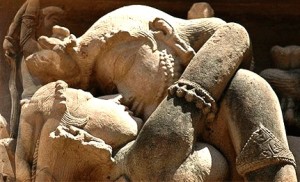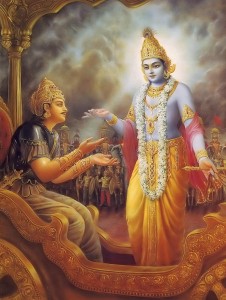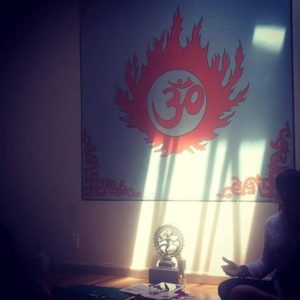We have been contemplating the four goals life, the “chatur purusharthas” for the past few weeks (they are Dharma, Artha, Kama and Moksha). Yoga is said to bring about fruition of these goals, and today we have come to “Kama,” which means sense pleasure, especially sexual and erotic pleasure.
This word Kama is familiar to us from hearing about the Kama Sutra. Sutras are pithy sayings and the Kama Sutra – turns out scholars are dating it between 200 BC and 400 AD – is like an ancient sex manual with sex tips and instructions on kissing, different strokes and oral sex and different ways of giving pleasure, some of it kind of weird. And it is also a kind of cultural document which begins with how you should bathe, make sure your mouth is clean and how you have to chew certain leaves to sweeten your breath and don’t put on too much scent – stuff like that.
I’m so relieved to be told that it is a sacred duty to fulfill love in this intensely pleasurable and vulnerable way of giving and receiving. In allowing yoga to break me out of the bonds of my conditioning, especially some unfortunate religious conditioning, it is thrilling to consider that this aspect of life is sacred, and we can wholeheartedly embrace the pleasures of the senses as one of the reasons we incarnate on this plane.
The Kama Sutra reminds us of this: that sense pleasure requires skill. There is the skill involved in creating those erotic sensual pleasures and in sensory delight of the delicious food, beautiful music, art and architecture, which is the dharma of artists and creative people. And there is also the skill of enjoyment. The practice of yoga sharpens our capacity for enjoyment by helping us understand the nuances and uses of restraint. (no, i am not talking about whips and chains – not that i have a problem with that! – but i am speaking about how holding back, anticipation, amplifies pleasure. It’s like that adage “hunger is the best sauce.” ) We all know the fallacy of thinking, if a little bit is good, more must be better? There is a law of diminishing returns in the pursuit of sensual satisfaction. The senses become jaded with too much stimulation and we end up seeking more and more extreme or varied experiences to have a reaction. In yoga we are able to cleanse and refresh the senses and keep them supple through “pratyahara,” the fifth limb of Patanjali’s eight limbs of yoga. Pratyahara means restraining, withdrawing the naturally outgoing awareness to the interior of one’s being.
So with hatha yoga we accomplish pratyahara through breath awareness and also by tuning in through asana to the sensations of our own musculature and nervous system. Yoga movements are training the attention to draw toward the spinal axis, and more subtly, the central channel within the spine, the inner spiritual energy which Christ refers to as the vine, where ‘rivers of living water’ are flowing. Drawing our senses into these deeper layers is like giving them a dip in the Void, and we emerge from such a meditation seeing that everything looks new and sparkling. It’s not the world that is new and sparkling, it is your perception. My Guru spoke in his book “Play of Consciousness” about how yoga satisfies the cravings of the senses with the supremely delightful inner sounds, visions, sensations and even tastes that are continuously revealed in the pursuit of yoga sadhana.
There is an ancient object of veneration in the yoga tradition called the “Shiva Linga” and it is nothing more or less than a simple phallic stone, which is usually standing up within a base called a “yoni” representing the female sexual organ. The worship of the linga entails some very erotic stuff like pouring milk and ghee over it, but for yogis, what is interesting is the interior linga, the upward flowing prana in the central channel which penetrates the chakra lotuses giving them the sweet elixir of life. This was the worship advocated by a wonderful sect of yogis that arose in the 12th century called “Vira Shaivites” who worshipped the linga. They forbade attendance of external temples, and proclaimed that the body was the only real temple which must be entered to have an encounter with the Absolute. God exists in the temple of the body. Here is a favorite poem from Basava, a leader of the movement:
The rich will make temples for Shiva.
(Basava 1134-1196)
What shall I, a poor man, do?
My legs are pillars, The body the shrine,
The head a cupola of gold.
Listen, O Lord, things standing shall fall,
but the moving ever shall stay.
The word root of “vira” in Virashaivism is where we get our word for virile, and it is this upward moving conscious energy that was venerated. Sometimes this is called the prana linga, the prana danda (stick of prana) or the jyotir linga, the linga made of Light. This is “the force that through the green fuse drives the flower” as Dylan Thomas puts it.
When we do yoga, we oblate the prana linga with our love, stroking it with the breath awareness moving down and up the linga, and as we open the heart center with love we cause it to swell within us. There is a word to describe this divine energy: Nityodita – infinitely arising. It is the masculine aspect of God, infinitely becoming, moving upward and expanding.
Let the inhalation be accompanied by a sense of receiving – allow love to come into you deeply and fill you down to your root. You know how St Francis says “it is in giving that we receive.”? Well, it is in receiving that we give, too. To enjoy the pleasures of the senses you have to be able to receive, paradoxically to let go and be abandoned, which is hard for some of us because giving puts you in control, and receiving, not so much. So we practice yoga for the courage to be sensitive and to abandon ourselves to reality. You can eventually experience that the moving breath is a luscious exchange going on between you and the Beloved, and that energy will give you more and more intimations of a cosmic eros occurring within.
But how does yoga enhance our physical pleasure here in the corporeal,on the carnal level? Lets get started with the mula bandha. Doing the mula bandha gives you really good tone in the sexual area of the body – it “innervates” the sexual organs, perfusing them with blood supply and all this toning you will see makes the orgasm stronger and more pervasive in the body, (Have i got your attention now?) and it also reverses the age-related atrophy of these vital organs.
Here’s how we do it: You breathe all the way down to the floor of the body- take your attention and drive it with the breath to the perineum, the muscle that is between the anus and the urethra, and now when you exhale fully youre going to squeeze the heck out of that muscle, draw it up along with the genital muscles and anything else you can find down there. But when you breathe out, you are going to hiss, or, putting your tongue to teeth, make the breath come out of a very small opening, so it is hard to expel the air, as hard as you can make it. This is because you have a deep abdominal muscle called the transversus abdominus which wraps around the pelvis like a girdle. This muscle is used in expulsion, breathing out, coughing, and expulsion downward, bearing down. Making it hard to expel the air works that muscle – you cant do sit ups for that one.
So now, breathe down to your root (your mula) and tongue to teeth, squeeze the breath out, pulling up, get a hold of yourself! And at the end of the breath, continue to hold the breath out as Patanjali instructs in the Yoga Sutras (2:49-53) . The holding of the breath in or out is called kumbhaka. Hold it to the count of 7 if you can. When you finally breathe in you’ll feel a little taste of bliss, so we’ll hang out there for a while because thats when pratyahara becomes natural and we are easily magnetized to the inner being. Kumbhaka quiets the mind and when your mind’s a blank, let the senses drink from that Nothingness as from an oasis.
So Kama is one of the four goals of life, and these goals are also pillars of creation. Yoga, which is a Tantric methodology, provides a way of appreciating and aligning ourselves with the tremendous force of sexuality in the universe, instead of laughably attempting to subdue, demonize or ignore it. We enjoy seeing the whole creation as the love play of Shiva and Shakti, or Purusha and Prakriti – the God and the Goddess, Yin and Yang, and in their climactic Big Bang, the constant birth of the Universe.











Leave a Reply